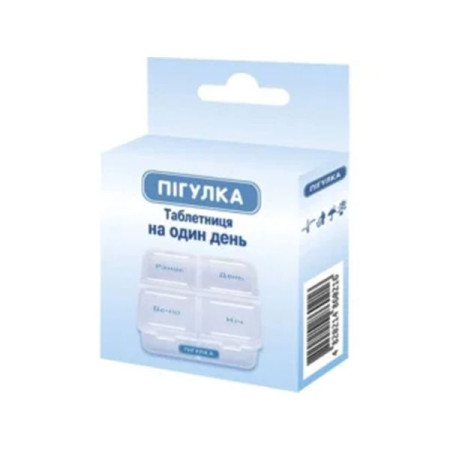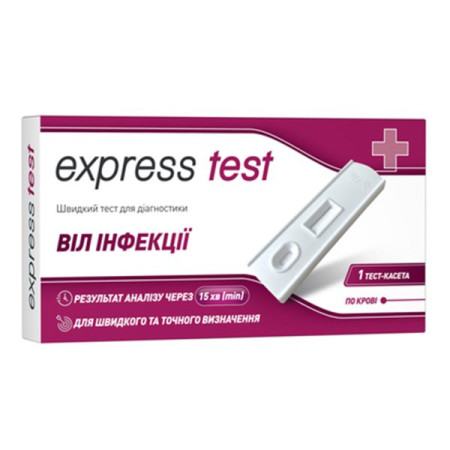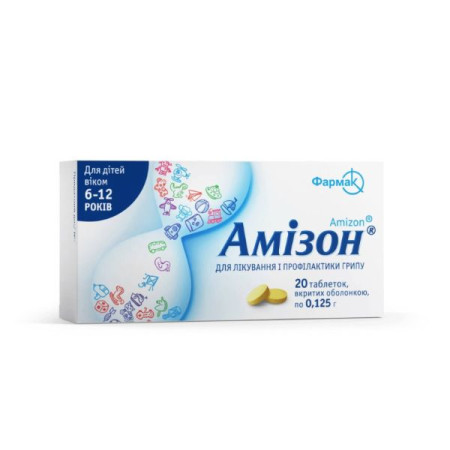Amizon tablets 0.25 No. 40

Instructions Amizon tablets 0.25 No. 40
Composition
active ingredient: amison® (enisamium iodide);
1 tablet contains Amizon® (enisamium iodide) 125 mg (0.125 g) or 250 mg (0.25 g);
excipients: lactose monohydrate, microcrystalline cellulose, povidone, croscarmellose sodium, calcium stearate;
shell: OPADRY II Clear 85F19250 (polyethylene glycol, polysorbate 80, polyvinyl alcohol, talc).
Dosage form
Film-coated tablets.
Main physicochemical properties: round, biconvex, yellow or yellow-green tablets, coated. Minor inclusions are allowed on the surface of the core tablets.
Pharmacotherapeutic group
Antiviral agents for systemic use. Direct-acting antiviral agents.
ATX code J05A X17.
Pharmacological properties
Mechanism of action
The antiviral effect of enisamium is associated with inhibition of influenza virus RNA polymerase. Enisamium iodide effectively inhibited SARS-CoV-2 virus replication in vitro in Caco-2 cells.
Pharmacodynamics
Enisamium has antiviral activity against various strains of influenza A virus (H1N1, H3N2, H5N1, H7N9), influenza B virus, respiratory syncytial virus, as well as strains of alpha-coronavirus NL-63 and beta-coronavirus SARS-CoV-2 in vitro.
Enisamium iodide has demonstrated efficacy against influenza A and B virus strains in in vitro studies using differentiated normal human bronchial epithelial cells (NHBE), human hepatocellular carcinoma cells (HepG2), human rhabdomyosarcoma (RD) cells, and human colorectal adenocarcinoma (Caco-2) cells. In ferrets, a representative animal model for influenza research: enisamium iodide reduced the time to shedding influenza virus from nasal washes of ferrets compared to a placebo control group.
Clinical efficacy
In a study in patients with acute respiratory viral infections, including influenza, treatment with enisamium iodide tablets at a daily dose of 1500 mg (2 tablets of 250 mg 3 times a day) provided positive dynamics of the disease, manifested by a more pronounced reduction in symptoms of viral infection compared to placebo (Table 1).
An early and statistically significant reduction in viral antigens in nasal swabs was found in patients treated with Amizon® compared to placebo (Table 2).
Enisamium treatment resulted in increased serum interferon levels compared to the placebo group.
Table 1.
Relief of symptoms of viral infection after treatment with Amizon® (number of patients / %)
| Era | Cough | Rhinitis | Weakness | Headache | ||||
| Amizon® | Placebo | Amizon® | Placebo | Amizon® | Placebo | Amizon® | Placebo | |
| 0 | 59 98.3% | 40 100% | 56 93.3% | 37 92.5% | 59 98.3% | 40 100% | 56 93.3% | 34 85% |
| 3 | 58 96.7% | 40 100% | 50 83.3% | 35 87.5% | 42 70% ** | 39 97.5% | 31 51.7% | 25 62.5% |
| 7 | 39 65% | 38 95% | 13 21.7% | 29 72.5% | 17 28.3% | 22 55% | 6 10% * | 13 32.5% |
| 14 | 4 6.7% | 22 55% | 0 | 2 5% | 1 1.7% | 7 17.5% | 0 | 3 7.5% |
Table 2.
Dynamics of viral antigen detection (number of patients / %)
| Era | Viral antigens | Influenza virus antigens | ||
| Amizon® | Placebo | Amizon® | Placebo | |
| 0 | 60 (100%) | 40 (100%) | 33 (66%) | 22 (55%) |
| 3 | 17 (28.3%) | 29 (72.5%) | 8 (13%) | 16 (40%) |
| 7 | 1 (1.7%) | 6 (15%) | 1 (1.7%) | 1 (2.5%) |
Results of a phase III clinical trial showed that enisamium iodide was well tolerated and clinically effective, as demonstrated by:
- reduction in the duration of the period of elevated temperature by 1.1 days;
- reduction of the duration of catarrhal and constitutional symptoms;
- reducing the use of expectorants and vasoconstrictors;
- reduction in the number of days of incapacity for work;
- a reduction in the period of viral shedding and a significant reduction in the number of patients in whom viral antigens were detected, compared to the group of patients receiving placebo.
Greater efficacy of enisamium was observed when treatment was started earlier.
Pharmacokinetics
Absorption
Enisamium iodide is rapidly absorbed: peak plasma concentrations are reached 1.6–2.4 hours after a single dose. Absolute bioavailability in humans has not been studied, while relative bioavailability is less than 5%. Steady state is reached after 3 days of oral administration of 500 mg three times a day and 1000 mg twice a day. No accumulation of the drug has been observed.
Food significantly reduced the bioavailability of enisamium iodide. The mean Cmax and AUCinf values for 1500 mg administered after food were reduced by 46.8% and 26.6%, respectively, compared to those for 1500 mg administered in the fasted state. The mean tmax was delayed by 0.75 hours in the fasted state and 2.75 hours in the fed state.
Distribution
The degree of binding of enisamium iodide to serum proteins in humans is low.
Biotransformation
The parent compound (enisamium iodide) is partially converted in humans by hydroxylation and glucuronic acid conjugation (less than 5%). CYP 2D6 probably plays a minor role in the metabolism of enisamium iodide. Other cytochrome P450 enzymes studied do not have a significant effect on the metabolic transformation of the parent compound.
Elimination
Enisamium iodide is mainly excreted unchanged in the urine. After oral administration of radiolabeled enisamium iodide to dogs, excretion in the feces was 32–35%. The median half-life of single doses of enisamium iodide ranges from 2.69 to 3.35 hours and from 6.00 to 7.34 hours after multiple administration over 10 days.
Pharmacokinetics in specific patient groups
Elderly patients
Pharmacokinetic studies in elderly patients have not been conducted.
Patients with liver and kidney damage
The pharmacokinetics of enisamium iodide in special populations have not been studied. However, based on the results of pharmacokinetic studies, given the presence of renal and enteral routes of excretion, as well as the low level of metabolism of enisamium iodide, in subjects with organic liver and kidney damage, no significant accumulation of enisamium in plasma should be expected during short-term use (up to 7 days) of this drug. Thus, a deterioration in the safety profile in patients with the above-mentioned organic diseases is unlikely.
Indication
Amizon® is indicated for the treatment and prevention of influenza and acute respiratory viral infections.
Contraindication
Hypersensitivity to drugs containing iodide, molecular iodine or covalently bound iodine, as well as to other components of the drug.
Interaction with other medicinal products and other types of interactions
Enisamium iodide may reduce the uptake of radioactive iodine isotopes by the thyroid gland for up to 6 weeks.
The simultaneous use of iodine-containing drugs, as well as contrast agents and drugs containing covalently bound iodine, should be avoided; treatment of large wounds with iodine-containing antiseptics (e.g., molecular iodine) due to a possible increased risk of thyroid dysfunction.
Application features
Enisamium iodide administration leads to an increase in plasma iodide levels. The secondary increase in circulating iodide levels triggers a self-regulation mechanism of thyroid function, in which the uptake of inorganic iodide by thyrocytes is inhibited, which helps prevent excessive thyroid hormone production; at the same time, the level of thyroid-stimulating hormone increases transiently (Wolf-Chaikoff phenomenon). This effect lasts for several days; after discontinuation of treatment, thyroid function returns to normal. In some cases, a transient increase in thyroid-stimulating hormone has been observed for several weeks.
There is no information on the effects of enisamium iodide on patients with thyroid dysfunction or patients with pre-existing hypothyroidism. However, it is advisable to monitor thyroid function during treatment with enisamium iodide.
Other iodine-containing drugs are not recommended for use during treatment and for 7 days after the end of treatment with enisamium iodide.
Excipients
Lactose content in Amizon® 0.125 g tablet: 5.225 mg/tablet or 0.0153 mmol/tablet or 3.37% of the total weight of the tablet.
Lactose content in Amizon® 0.250 g tablet: 10.45 mg/tablet or 0.0306 mmol/tablet or 3.37% of the total weight of the tablet.
If you have been told by your doctor that you have an intolerance to some sugars, contact your doctor before taking Amizon®. Lactose-free capsules may be prescribed for such patients.
Sodium content in Amizon® 0.125 g tablet: 0.285 mg/tablet or 0.0124 mmol/tablet or 0.18% of the total weight of the tablet.
Sodium content in Amizon® 0.250 g tablet: 0.570 mg/tablet or 0.0248 mmol/tablet or 0.18% of the total weight of the tablet.
This medicinal product contains less than 1 mmol (23 mg) sodium/dose, i.e. essentially 'sodium-free'.
Use during pregnancy or breastfeeding
The drug is contraindicated for use during pregnancy, as clinical studies of enisamium iodide in pregnant women have not been conducted. Animal studies have not shown direct or indirect effects on reproductive function/fertility.
Breast-feeding
It is not known whether enisamium iodide or its metabolites are excreted in human milk. A risk to the newborn/infant from enisamium iodide cannot be excluded.
Ability to influence reaction speed when driving vehicles or other mechanisms
Taking Amizon® does not affect the ability to drive or operate other mechanisms.
Method of administration and doses
Enisamium iodide tablets are swallowed without chewing 2 hours before meals.
The maximum single dose is 1000 mg (1 g), the maximum daily dose is 2000 mg (2 g).
Treatment: Adults are prescribed enisamium iodide at a dose of 500 mg (0.5 g) 3 times or 1000 mg (1 g) 2 times a day.
Children over 12 years of age are prescribed enisamium iodide at a dose of 500 mg (0.5 g) 3 times a day.
Children aged 6 to 12 years are prescribed 125 mg (0.125 g) 2–3 times a day.
Duration of treatment is 7 days.
Prevention. Adults and children over 16 years old - 250 mg (0.25 g) per day for 3-5 days, then 250 mg (0.25 g) once every 2-3 days for 2-3 weeks; children 6-12 years old - 125 mg (0.125 g) every other day for 2-3 weeks; children 12 to 16 years old - 250 mg (0.25 g) every other day for 2-3 weeks.
Children
The drug in this dosage form should not be used in children under 6 years of age.
Overdose
No reports of overdose with Amizon® have been received in clinical trials or during post-marketing use.
There is no specific antidote.
Adverse reactions
The most common adverse reactions (ADRs) were taste disturbance, folliculitis, nasopharyngitis, headache, and lymphadenopathy (in placebo-controlled phase I studies). Most of these ADRs were reported as single events and resolved spontaneously. In most patients, these ADRs did not lead to discontinuation of enisamium iodide.
In a placebo-controlled phase III study, mild gastrointestinal disturbances (bitter taste in the mouth), heartburn, and burning in the throat were reported.
Only adverse events that were more common in the enisamium iodide group compared to the placebo group and that were reported by more than two individuals were considered.
Table 3 lists the adverse reactions observed during clinical trials and post-marketing use of the drug. The frequency is defined as follows: very common (≥1/10), common (≥1/100, <1/10), uncommon (>1/1,000, <1/100) and unknown (cannot be estimated from the available data).
Table 3.
| Organ system class | Very often | Often | Infrequently | Frequency unknown* |
| Research | - | Elevated levels of thyroid-stimulating hormone in the blood | - | Increased blood pressure |
| General disorders | - | Fatigue | - | - |
| Infections and infestations | - | Folliculitis Nasopharyngitis Rhinitis | - | - |
| Respiratory, thoracic and mediastinal disorders | - | - | - | Dyspnea |
| Blood and lymphatic system disorders | - | Lymphadenopathy | - | - |
| Nervous system disorders | Headache | Dizziness | - | - |
| Visual impairment | - | - | - | Eyelid swelling |
| Musculoskeletal and connective tissue disorders | - | Arthralgia | - | - |
| Skin and subcutaneous tissue disorders | - | - | - | Erythema Facial swelling Facial itching Edema Itch Rash Papular rash Urticaria |
| Gastrointestinal disorders | - | Diarrhea Dry mouth Taste disorders Dyspepsia Nausea Vomiting | - | Abdominal pain |
* Post-registration notifications
Reporting of suspected adverse reactions
Reporting suspected adverse reactions after a medicinal product has been authorised is essential. This ensures continuous monitoring of the benefit/risk balance of the medicinal product. Healthcare professionals are asked to report all suspected adverse reactions via the national reporting system.
Expiration date
4 years.
Do not use the drug after the expiration date indicated on the package.
Storage conditions
Store in a place protected from light at a temperature not exceeding 25 °C.
Keep out of reach of children.
Packaging
Film-coated tablets, 0.125 g each. 10 tablets in a blister, 1 or 2 blisters in a pack or 20 tablets in a blister, 1 blister in a pack.
Film-coated tablets, 0.25 g each. 10 tablets in a blister, 1 blister in a pack or 20 tablets in a blister, 1 or 2 blisters in a pack.
Vacation category
Without a prescription.
Producer
JSC "Farmak".
Location of the manufacturer and its business address
Ukraine, 04080, Kyiv, Kyrylivska St., 74.
There are no reviews for this product.
There are no reviews for this product, be the first to leave your review.
No questions about this product, be the first and ask your question.







